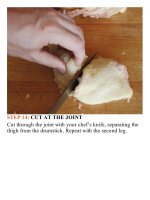The food lab better home cooking through science ( PDFDrive ) 187
Bạn đang xem bản rút gọn của tài liệu. Xem và tải ngay bản đầy đủ của tài liệu tại đây (177.62 KB, 2 trang )
RollinginDough
Stickybunsaremadewithwhatiscalledanenricheddough,
meaning that in addition to the flour, water-based liquid,
salt,andleavenerfoundinmostdoughs,you’vealsogotfat
—in this case, eggs and butter; ingredients like milk and
yogurtprovidebothwaterandfat.Thefatplaysavitalrole
notonlyintheflavorofthebuns,butalsointheirtexture.In
lean doughs made without fat, gluten formation is
exceptionally strong, because the flour proteins are easily
able to come into direct contact with one another, rapidly
forming a thick, sticky network of gluten. Because of this,
leandoughstendtohavelargerairbubblestrappedinthem
(stronger gluten means the dough can stretch longer and
thinner before bursting), as well as a tougher, chewier
structure.Withenricheddoughs,thefatsactlikealubricant,
preventingproteinsfrombondingtootightly.
Think of flour proteins as a group of hippie revelers
forming a dance circle during a rare dry, sunny moment at
Woodstock 1969. As they run into each other, they clasp
each other’s hands (as hippies are wont to do). Eventually,
they’re all linked together quite tightly. The circle can
stretch out very far before any link breaks. Now let’s
imaginethesamegroupofhippiesinthesamefield,butthis
timeinthepouringrain.Ifcoated,astheyare,withmudand
water, clasping hands tightly becomes much more difficult.
Perhaps small circles form here andthere, but they are
nowherethesizeandstrengthofthedrycircle.Soitiswith
fats:theypreventlargehippiecirclesofflourfromforming
inyourdough,sotospeak.
Becauseofthis,enricheddoughstendtobemoredelicate
than lean doughs, with a softer texture and smaller air
bubbles.Ofcourse,fatsalsoaddcolorandflavortodoughs.
What fun would sticky buns be if they weren’t golden and
buttery?
There are recipes for sticky buns that use chemical
leavenerslikebakingpowdertoinducearapidrise,butthis
technique compromises flavor. Yeast is the only way to
properly develop flavor and texture in a sticky bun. See,
yeasts, like pretty much all living creatures, have a strong
desire to procreate, and in order to do that, they must
consume energy. This energy consumption comes in the
formofsugars,whichtheydigestandletoffasbothcarbon
dioxide and alcohol, along with numerous other aromatic
compounds. It’s the carbon dioxide getting trapped in the
network of gluten formed by the flour that acts to leaven
yeasted baked goods. The process takes time, however.
There’s only so much procreating a yeast can do, you
know? A properly leavened sticky bun dough can take
severalhourstoproduce.
Well,whycan’tIjustaddmoreyeasttostart? youmight
ask.The problem is that yeast has a flavor of its own, and
it’snotaparticularlypleasantone.Startwithatonofyeast,
anditsslightlybitter,funkyflavorwilldominatethedough.
The flavor of properly risen dough comes from thebyproducts of the yeast’s actions: the complex array of
aromatic chemicals that are produced as yeast slowly,
slowly digests the sugars in the dough. For the best flavor,
you must start with a relatively small amount of yeast and
allow it plenty of time to perform its magic.This is as true
forstickybunsasitisforpizzadoughorbaguettes.









